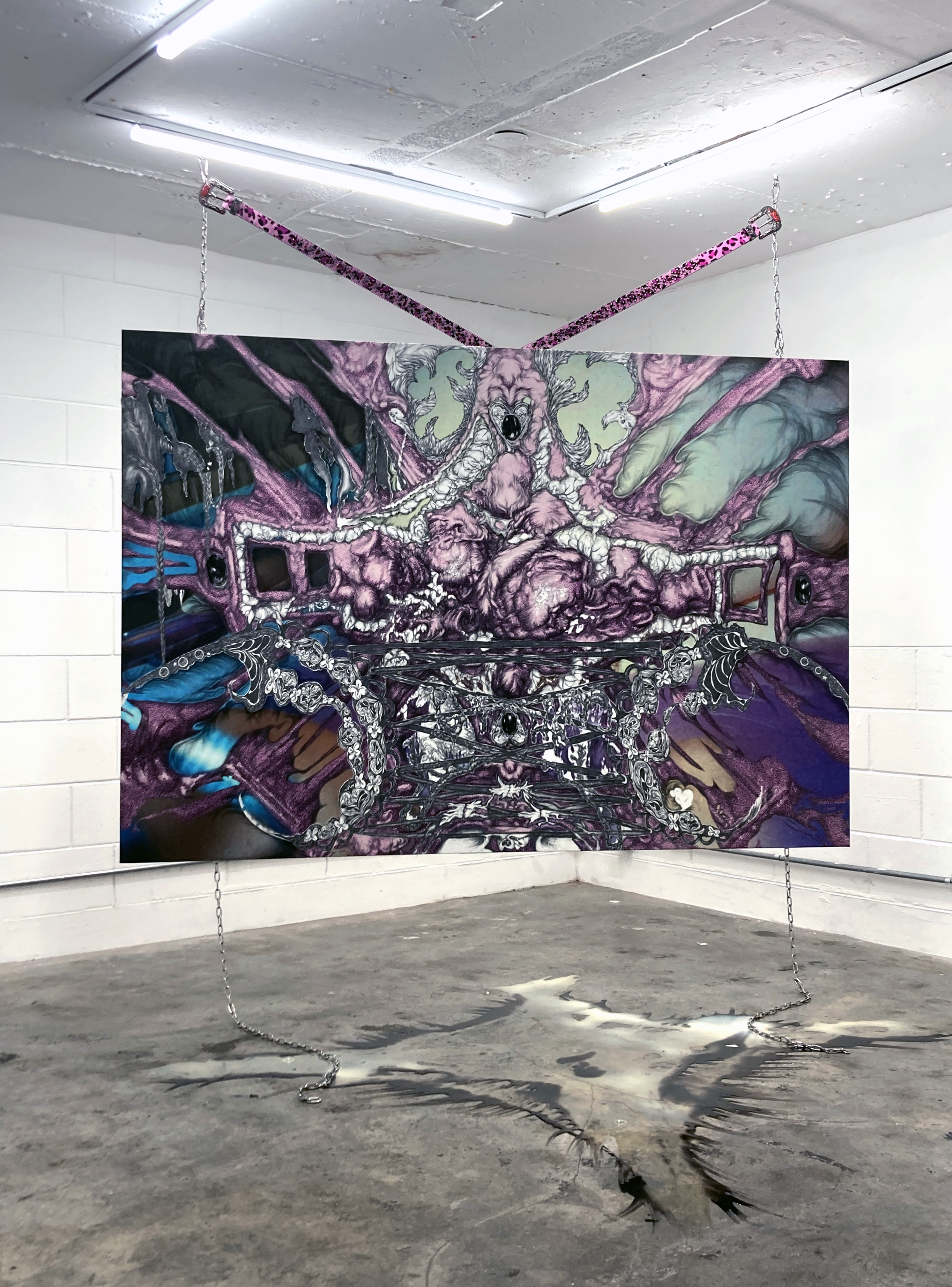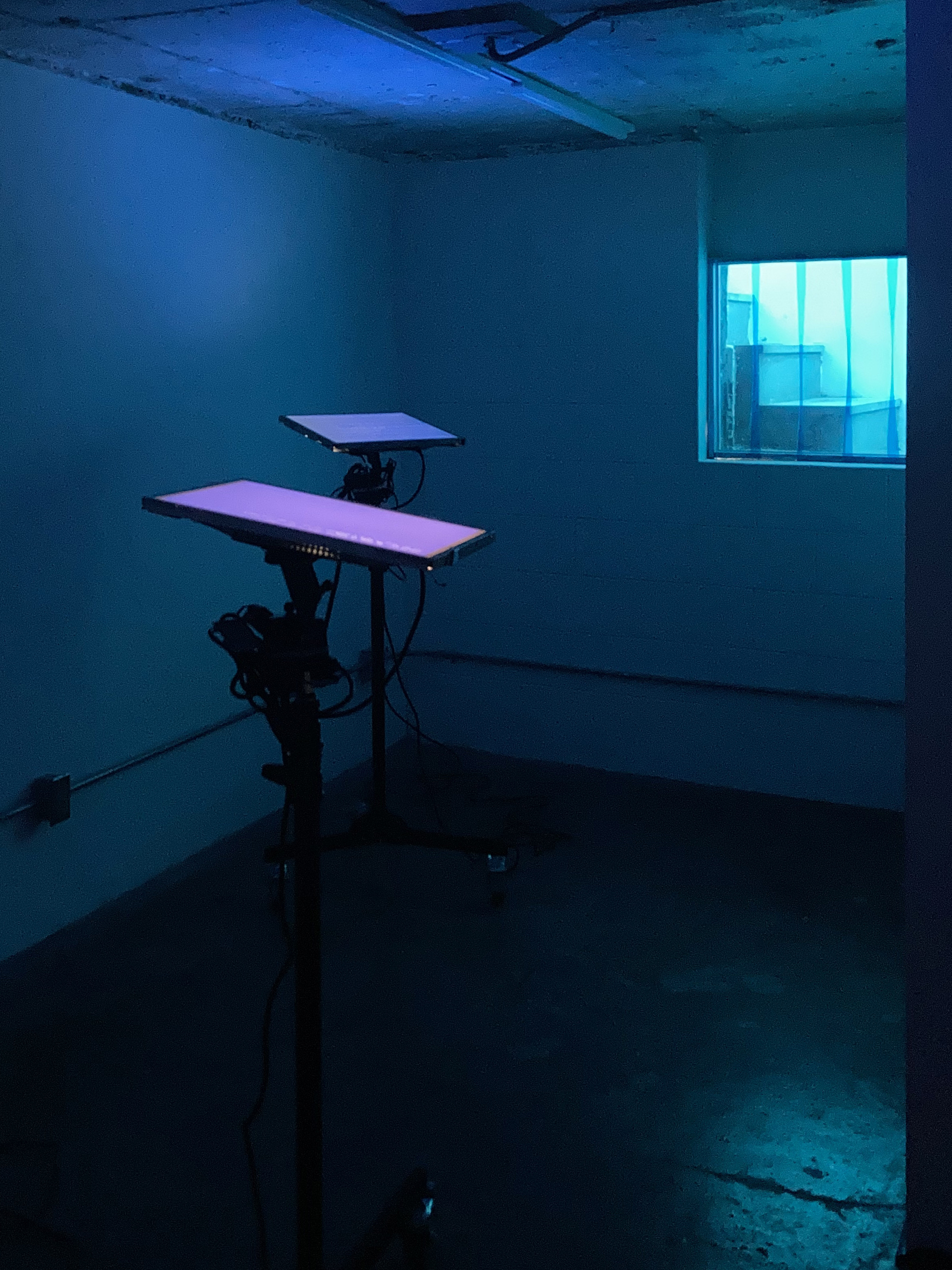Until Fingerprints Are Gone
지문이 닳도록
White Noise, Seoul, KR
2024. 07. 10 ~ 2024. 07. 21




The exaggerated expression "Until fingerprints are gone" in Korea implies that a physical action has been performed repeatedly with extensive time and effort to make the near-impossible task of removing fingerprints possible. This phrase can be applied to various physical acts, but consistently accompanies one particular act: 'rubbing'. Fingerprints can wear down through friction generated by extreme rubbing against a surface, typically involving small, limited surfaces like fingers.
British-based artist B.A. Zanditon, who explores rubbing, questions why rubbing feels particularly personal and secretive. She suggests it always relates to institutional power dynamics. The subjects of all rubbings belong somewhere—whether bodies, objects, private lands, or public places—always assigning responsibility to the subject. Exceptions allow for contact and invasion. Zanditon contends that rubbing does not damage surfaces but is conditional and speculative, focusing on the subject, the object, and their surroundings.1
However, if rubbing becomes intense and repetitive, leading fingerprints to wear down, it means deeper damage beyond the surface, revealing inner layers. This action of breaching limited access boundaries beyond offered superficial assumptions requires responsibility with risks of impermissibility. Therefore, the works of the two artists in this exhibition with the title “Until Fingerprints Are Gone”, presuppose rubbing as an exploration of power relations and societal norms entrenched like innate skin, resonating deeply through everyday repetitive questions rather than a visible event like revolt. They delve into a light feasible resistance, aiming to expose layers through durable damage akin to the area and depth of fingerprints.
Yoonjae Lee is the artist who personifies AI as an organism and uses text-based questions to gain physical body information from it then converts it into visual images. The recorded conversations are displayed on the now rarely used LCDs with frames taken off, which eventually revealed the error of conflicting optical and linguistic information.2 This reevaluates the socialized meanings of the body and senses recognized by technology. Meanwhile, Jeon In combines images and symbols of queer women’s fetishistic exposure, BDSM, and other sexual acts neglected by society. She prints these on paper and peels and tears its surface. Above it, she draws akin to the way of tattoo, transforming the damage into decoration and imbuing it with new subjectivity.3 In this exhibition, both artists overlay the process and images of their fingerprint-wearing “rubbing” on each other, attempting to make new texture on works while exploring alternative senses and different gender information collectively.
Slowly, stealthily, the flesh of her fingertips are grounded. Without dropping a drop of red blood, but with a blue glow.
1 Zanditon, B.A. “Surface/Touch.” In Touch, edited by Caterina Nirta, Danilo Mandic, Andrea Pavoni, and Andreas Philippopoulos-Mihalopoulos, 3:235–54. University of Westminster Press, 2020. http://www.jstor.org/stable/j.ctv11cvxbx.9.
2 It is undeniably true that it is digital devices that are rubbing with our fingerprints the most nowadays.
3 To add, “Frottage”, the technique utilizing rubbing, is also used as a term for non-insertion sex. If the intensive rubbing can be read as a resistance to conventional institutions such as patriarchy, then rubbing in this text can also be interpreted as an act of queer feminism.
British-based artist B.A. Zanditon, who explores rubbing, questions why rubbing feels particularly personal and secretive. She suggests it always relates to institutional power dynamics. The subjects of all rubbings belong somewhere—whether bodies, objects, private lands, or public places—always assigning responsibility to the subject. Exceptions allow for contact and invasion. Zanditon contends that rubbing does not damage surfaces but is conditional and speculative, focusing on the subject, the object, and their surroundings.1
However, if rubbing becomes intense and repetitive, leading fingerprints to wear down, it means deeper damage beyond the surface, revealing inner layers. This action of breaching limited access boundaries beyond offered superficial assumptions requires responsibility with risks of impermissibility. Therefore, the works of the two artists in this exhibition with the title “Until Fingerprints Are Gone”, presuppose rubbing as an exploration of power relations and societal norms entrenched like innate skin, resonating deeply through everyday repetitive questions rather than a visible event like revolt. They delve into a light feasible resistance, aiming to expose layers through durable damage akin to the area and depth of fingerprints.
Yoonjae Lee is the artist who personifies AI as an organism and uses text-based questions to gain physical body information from it then converts it into visual images. The recorded conversations are displayed on the now rarely used LCDs with frames taken off, which eventually revealed the error of conflicting optical and linguistic information.2 This reevaluates the socialized meanings of the body and senses recognized by technology. Meanwhile, Jeon In combines images and symbols of queer women’s fetishistic exposure, BDSM, and other sexual acts neglected by society. She prints these on paper and peels and tears its surface. Above it, she draws akin to the way of tattoo, transforming the damage into decoration and imbuing it with new subjectivity.3 In this exhibition, both artists overlay the process and images of their fingerprint-wearing “rubbing” on each other, attempting to make new texture on works while exploring alternative senses and different gender information collectively.
Slowly, stealthily, the flesh of her fingertips are grounded. Without dropping a drop of red blood, but with a blue glow.
Jungmin Cho (Director, White Noise)
1 Zanditon, B.A. “Surface/Touch.” In Touch, edited by Caterina Nirta, Danilo Mandic, Andrea Pavoni, and Andreas Philippopoulos-Mihalopoulos, 3:235–54. University of Westminster Press, 2020. http://www.jstor.org/stable/j.ctv11cvxbx.9.
2 It is undeniably true that it is digital devices that are rubbing with our fingerprints the most nowadays.
3 To add, “Frottage”, the technique utilizing rubbing, is also used as a term for non-insertion sex. If the intensive rubbing can be read as a resistance to conventional institutions such as patriarchy, then rubbing in this text can also be interpreted as an act of queer feminism.
“지문이 닳도록” 이라는 표현은 어떠한 물리적 행위가 지문이 사라지는 불가능에 가까운 일이 가능해질만큼 많은 시간과 노력 하에 반복적으로 행해졌음을 의미한다. 이 수식어구는 신체가 사용되는 다양한 상황에 적용이 가능하지만 일관되게 전제되는 행위가 있다. 그것은 ‘문지르기' 이다. 지문은 피부가 대상에 맞대어 문질러짐을 통해 닳음의 가능성을 동반하는 마찰을 발생시키며 이는 보통 손가락과 같이 작은 한정된 표면 간에 이뤄진다. 이러한 ‘문지르기' 는 매우 사적이고 탐색적이다.
영국을 기반으로 활동하며 문지르기(rubbing)를 탐구해온 작가 B.A. Zanditon 은 문지르기가 왜 유독 개인적이며 비밀스럽게 느껴지는가 질문하며 이는 항상 제도적 권력에 관한 것이라고 말한다. 모든 문지름의 대상은 신체, 물체, 사유지, 공공장소 등 어딘가에 속해 있다. 때문에 항상 주체에게는 책임이 주어지며, 예외적으로 접촉과 침입이 인정되는 상황들이 있다. 그녀는 문지르기는 표면을 손상시키지 않으며 일시적인 인상에 그치기에 조건적, 추측적이므로 행위자와 대상의 관계, 그를 둘러싼 외부환경에 초점을 둔다. 1
하지만 문지르기가 극단적으로 반복되어 지문이 닳을 지경이 되면 표면을 넘어서 깊이가 발생하고 내부가 드러나는 훼손이 된다. 이는 대상에 대한 피상적인 추측에서 끝나지 않고 제한된 접근 범위를 넘어 관계에 상관없이 예외적 포용이 불가능할 위험 속의 책임을 요한다. 고로 강도 높은 문지르기를 전제로 하는 지문이 닳도록이 제목으로서 수식하는 두 작가의 작업은 벗겨낼 수 없는 타고난 피부처럼 안착한 권력관계와 사회적 통념에 거대한 반향을 일으키기보다 일상 속 반복적 질문들로 지문만큼의 면적과 그 두께만큼, 실천 가능한 훼손을 통해 이면을 드러내고자하는 얕은 저항의 굴착이 된다.
이윤재는 AI를 유기적 개체로 상정하고 텍스트 기반의 질문을 던지는 채팅을 통해 신체 정보를 얻어 이를 영상이미지로 변환함으로써 기술이 인식하는 사회화된 신체와 감각의 의미를 재고하고자 한다. 작가가 지문이 닳도록 키보드를 두드려 AI에게 얻어낸 답들은 현재는 거의 사용되지 않는 본체를 벗긴 LCD에 기록되어 결국 감각 정보가 시각과 언어 정보가 상충되는 오류를 드러낸다.2 전인은 퀴어 여성의 페티쉬적 노출, BDSM과 같은 외면 혹은 금기시되는 성적 행위의 이미지 및 심볼들을 합성해 장지에 인쇄하고 종이의 표면을 벗겨내며 타투하듯 드로잉을 한다.3 이러한 작업과정 속 기존의 여성의 섹슈얼리티 이미지와 매체 자체에 대한 지문이 닳도록 반복되는 훼손은 장식으로 변모되고 새로운 주체성을 갖게된다. 이번 전시에서 두 작가는 각자의 지문이 닳는 ‘문지르기'의 과정과 이미지를 중첩을 통한 질감화를 시도하기도하며 대안적 감각과 젠더 정보의 가능성을 함께 모색한다.
아주 느리고 은밀하게 손가락 끝의 살결이 갈린다. 빨간 피 한 방울 흘리지 않으며. 그러나 푸른 빛을 녹진히 흘리며.
조정민 (White Noise 디렉터)
1 Zanditon, B.A. “Surface/Touch.” In Touch, edited by Caterina Nirta, Danilo Mandic, Andrea Pavoni, and Andreas Philippopoulos-Mihalopoulos, 3:235–54. University of Westminster Press, 2020. http://www.jstor.org/stable/j.ctv11cvxbx.9.
2 실질적으로 우리의 지문이 닳도록 가장 많이 접촉하는 것은 디지털 기기들이 아니던가.
3 덧붙이자면 문지르기가 활용되는 기법인 프로타주 Frottage는 비삽입 섹스를 일컫는 용어로 쓰이기도 한다. 지문이 닳도록에 동반된 문지르기가 가부장제와 같은 관습적 제도에 대한 저항으로 읽을 수 있다면 본문에서 문지르기는 여성 퀴어적 행위로도 해석될 수 있을 것이다.
영국을 기반으로 활동하며 문지르기(rubbing)를 탐구해온 작가 B.A. Zanditon 은 문지르기가 왜 유독 개인적이며 비밀스럽게 느껴지는가 질문하며 이는 항상 제도적 권력에 관한 것이라고 말한다. 모든 문지름의 대상은 신체, 물체, 사유지, 공공장소 등 어딘가에 속해 있다. 때문에 항상 주체에게는 책임이 주어지며, 예외적으로 접촉과 침입이 인정되는 상황들이 있다. 그녀는 문지르기는 표면을 손상시키지 않으며 일시적인 인상에 그치기에 조건적, 추측적이므로 행위자와 대상의 관계, 그를 둘러싼 외부환경에 초점을 둔다. 1
하지만 문지르기가 극단적으로 반복되어 지문이 닳을 지경이 되면 표면을 넘어서 깊이가 발생하고 내부가 드러나는 훼손이 된다. 이는 대상에 대한 피상적인 추측에서 끝나지 않고 제한된 접근 범위를 넘어 관계에 상관없이 예외적 포용이 불가능할 위험 속의 책임을 요한다. 고로 강도 높은 문지르기를 전제로 하는 지문이 닳도록이 제목으로서 수식하는 두 작가의 작업은 벗겨낼 수 없는 타고난 피부처럼 안착한 권력관계와 사회적 통념에 거대한 반향을 일으키기보다 일상 속 반복적 질문들로 지문만큼의 면적과 그 두께만큼, 실천 가능한 훼손을 통해 이면을 드러내고자하는 얕은 저항의 굴착이 된다.
이윤재는 AI를 유기적 개체로 상정하고 텍스트 기반의 질문을 던지는 채팅을 통해 신체 정보를 얻어 이를 영상이미지로 변환함으로써 기술이 인식하는 사회화된 신체와 감각의 의미를 재고하고자 한다. 작가가 지문이 닳도록 키보드를 두드려 AI에게 얻어낸 답들은 현재는 거의 사용되지 않는 본체를 벗긴 LCD에 기록되어 결국 감각 정보가 시각과 언어 정보가 상충되는 오류를 드러낸다.2 전인은 퀴어 여성의 페티쉬적 노출, BDSM과 같은 외면 혹은 금기시되는 성적 행위의 이미지 및 심볼들을 합성해 장지에 인쇄하고 종이의 표면을 벗겨내며 타투하듯 드로잉을 한다.3 이러한 작업과정 속 기존의 여성의 섹슈얼리티 이미지와 매체 자체에 대한 지문이 닳도록 반복되는 훼손은 장식으로 변모되고 새로운 주체성을 갖게된다. 이번 전시에서 두 작가는 각자의 지문이 닳는 ‘문지르기'의 과정과 이미지를 중첩을 통한 질감화를 시도하기도하며 대안적 감각과 젠더 정보의 가능성을 함께 모색한다.
아주 느리고 은밀하게 손가락 끝의 살결이 갈린다. 빨간 피 한 방울 흘리지 않으며. 그러나 푸른 빛을 녹진히 흘리며.
조정민 (White Noise 디렉터)
1 Zanditon, B.A. “Surface/Touch.” In Touch, edited by Caterina Nirta, Danilo Mandic, Andrea Pavoni, and Andreas Philippopoulos-Mihalopoulos, 3:235–54. University of Westminster Press, 2020. http://www.jstor.org/stable/j.ctv11cvxbx.9.
2 실질적으로 우리의 지문이 닳도록 가장 많이 접촉하는 것은 디지털 기기들이 아니던가.
3 덧붙이자면 문지르기가 활용되는 기법인 프로타주 Frottage는 비삽입 섹스를 일컫는 용어로 쓰이기도 한다. 지문이 닳도록에 동반된 문지르기가 가부장제와 같은 관습적 제도에 대한 저항으로 읽을 수 있다면 본문에서 문지르기는 여성 퀴어적 행위로도 해석될 수 있을 것이다.
Credit
Artists
In Jeon, Yoonjae Lee
Curator
Jungmin Cho
Organized by
White Noise
Poster Design
Terri Kim
(Font by Xiaoyuan Gao)
Photography
In Jeon, Yoonjae Lee